Spatial Coupling Coordination Evaluation between Population Growth, Land Use and Housing Supply of Urban Agglomeration in China
Abstract
1. Introduction
2. Materials
2.1. Study Area
2.2. Indicator System and Data Source
3. Methods
3.1. Information Entropy Method
3.2. Coupling Coordination Degree Model
3.3. Spatial Coupling Coordination Degree Model
4. Results
4.1. Indicator Evolution Analysis
4.2. Coupling Coordination Analysis
4.3. Spatial Coupling Coordination Analysis
5. Conclusions and Recommendations
5.1. Conclusions
5.2. Recommendations
Author Contributions
Funding
Institutional Review Board Statement
Informed Consent Statement
Data Availability Statement
Conflicts of Interest
References
- Liu, Y.; Zhang, X.; Pan, X.; Ma, X.; Tang, M. The Spatial Integration and Coordinated Industrial Development of Urban Agglomerations in the Yangtze River Economic Belt, China. Cities 2020, 104, 102801. [Google Scholar] [CrossRef]
- Li, L.; Ma, S.; Zheng, Y.; Xiao, X. Integrated Regional Development: Comparison of Urban Agglomeration Policies in China. Land Use Policy 2022, 114, 105939. [Google Scholar] [CrossRef]
- Sun, C.; Zhang, S.; Song, C.; Xu, J.; Fan, F. Investigation of Dynamic Coupling Coordination between Urbanization and the Eco-Environment—A Case Study in the Pearl River Delta Area. Land 2021, 10, 190. [Google Scholar] [CrossRef]
- Abbasi, K.R.; Shahbaz, M.; Jiao, Z.; Tufail, M. How Energy Consumption, Industrial Growth, Urbanization, and CO2 Emissions Affect Economic Growth in Pakistan? A Novel Dynamic ARDL Simulations Approach. Energy 2021, 221, 119793. [Google Scholar] [CrossRef]
- Ye, C.; Sun, C.; Chen, L. New Evidence for the Impact of Financial Agglomeration on Urbanization from a Spatial Econometrics Analysis. J. Clean. Prod. 2018, 200, 65–73. [Google Scholar] [CrossRef]
- Zheng, W.; Walsh, P.P. Economic Growth, Urbanization and Energy Consumption—A Provincial Level Analysis of China. Energy Econ. 2019, 80, 153–162. [Google Scholar] [CrossRef]
- Tan, Y.; Xu, H.; Zhang, X. Sustainable Urbanization in China: A Comprehensive Literature Review. Cities 2016, 55, 82–93. [Google Scholar] [CrossRef]
- Han, H.; Li, H. Coupling Coordination Evaluation between Population and Land Urbanization in Ha-Chang Urban Agglomeration. Sustainability 2020, 12, 357. [Google Scholar] [CrossRef]
- Wan, J.; Zhang, L.; Yan, J.; Wang, X.; Wang, T. Spatial–Temporal Characteristics and Influencing Factors of Coupled Coordination between Urbanization and Eco-Environment: A Case Study of 13 Urban Agglomerations in China. Sustainability 2020, 12, 8821. [Google Scholar] [CrossRef]
- Fu, B.; Zhang, L. Land-Use Change and Ecosystem Services: Concepts, Methods and Progress. Prog. Geogr. 2014, 33, 441–446. [Google Scholar] [CrossRef]
- Tang, Y.; Wang, K.; Ji, X.; Xu, H.; Xiao, Y. Assessment and Spatial-Temporal Evolution Analysis of Urban Land Use Efficiency under Green Development Orientation: Case of the Yangtze River Delta Urban Agglomerations. Land 2021, 10, 715. [Google Scholar] [CrossRef]
- Tan, R.; Qu, F.; Heerink, N.; Mettepenningen, E. Rural to Urban Land Conversion in China—How Large Is the over-Conversion and What Are Its Welfare Implications? China Econ. Rev. 2011, 22, 474–484. [Google Scholar] [CrossRef]
- Zhang, W.; Shi, P.; Tong, H.; González-Jaramillo, H.; Novelli, A.; Zhang, W.; Shi, P.; Tong, H. Research on Construction Land Use Benefit and the Coupling Coordination Relationship Based on a Three-Dimensional Frame Model—A Case Study in the Lanzhou-Xining Urban Agglomeration. Land 2022, 11, 460. [Google Scholar] [CrossRef]
- Dong, L.; Longwu, L.; Zhenbo, W.; Liangkan, C.; Farming, Z. Exploration of Coupling Effects in the Economy–Society–Environment System in Urban Areas: Case Study of the Yangtze River Delta Urban Agglomeration. Ecol. Indic. 2021, 128, 107858. [Google Scholar] [CrossRef]
- Guo, J.; Yu, Z.; Ma, Z.; Xu, D.; Cao, S. What Factors Have Driven Urbanization in China? Environ. Dev. Sustain. 2021, 24, 6508–6526. [Google Scholar] [CrossRef]
- Lin, X.; Wang, Y.; Wang, S.; Wang, D. Spatial Differences and Driving Forces of Land Urbanization in China. J. Geogr. Sci. 2015, 25, 545–558. [Google Scholar] [CrossRef]
- Chan, K.W.; Xu, X. Urban Population Growth and Urbanization in China Since 1949: Reconstructing a Baseline. China Q. 1985, 104, 583–613. [Google Scholar] [CrossRef]
- Zhang, Y.; Su, Z.; Li, G.; Zhuo, Y.; Xu, Z. Spatial-Temporal Evolution of Sustainable Urban Development: A Perspective on the Coupling Coordination Development Based on Population, Industry, and Built-Up Land Spatial Agglomeration. Sustainability 2018, 10, 1766. [Google Scholar] [CrossRef]
- Davis, K. The Urbanization of the Human Population. City Read. 2015, 2015, 43–53. [Google Scholar] [CrossRef]
- Zhang, J. Urbanization, Population Transition, and Growth. Oxf. Econ. Pap. 2002, 54, 91–117. [Google Scholar] [CrossRef]
- Zhang, W.J. A Forecast Analysis on World Population and Urbanization Process. Environ. Dev. Sustain. 2007, 10, 717–730. [Google Scholar] [CrossRef]
- Myers, D.; Pitkin, J.; Park, J. Estimation of Housing Needs amid Population Growth and Change. Hous. Policy Debate 2010, 13, 567–596. [Google Scholar] [CrossRef]
- Mulder, C.H. Population and Housing: A Two-Sided Relationship. Demogr. Res. 2006, 15, 401–412. [Google Scholar] [CrossRef]
- Wang, Z.; Zhang, Q. Fundamental Factors in the Housing Markets of China. J. Hous. Econ. 2014, 25, 53–61. [Google Scholar] [CrossRef]
- Meyer, W.B.; Turner, B.L. Human Population Growth and Global Land-Use/Cover Change. Ann. Rev. Ecol. Syst. 1992, 23, 39–61. [Google Scholar] [CrossRef]
- Kalnay, E.; Cai, M. Impact of Urbanization and Land-Use Change on Climate. Nature 2003, 423, 528–531. [Google Scholar] [CrossRef]
- Tang, M.; Li, Z.; Hu, F.; Wu, B. How Does Land Urbanization Promote Urban Eco-Efficiency? The Mediating Effect of Industrial Structure Advancement. J. Clean. Prod. 2020, 272, 122798. [Google Scholar] [CrossRef]
- Lu, X.-H.; Ke, S.-G. Gan Evaluating the Effectiveness of Sustainable Urban Land Use in China from the Perspective of Sustainable Urbanization. Habitat Int. 2018, 77, 90–98. [Google Scholar] [CrossRef]
- Wang, J.; Lin, Y.; Glendinning, A.; Xu, Y. Land-Use Changes and Land Policies Evolution in China’s Urbanization Processes. Land Use Policy 2018, 75, 375–387. [Google Scholar] [CrossRef]
- Zhou, J.; Yu, X.; Jin, X.; Mao, N. Government Competition, Land Supply Structure and Semi-Urbanization in China. Land 2021, 10, 1371. [Google Scholar] [CrossRef]
- Wu, Y.; Hui, E.C.M.; Zhao, P.; Long, H. Land Use Policy for Urbanization in China. Habitat Int. 2018, 77, 40–42. [Google Scholar] [CrossRef]
- Ihlanfeldt, K.R. The Effect of Land Use Regulation on Housing and Land Prices. J. Urban Econ. 2007, 61, 420–435. [Google Scholar] [CrossRef]
- Du, H.; Ma, Y.; An, Y. The Impact of Land Policy on the Relation between Housing and Land Prices: Evidence from China. Q. Rev. Econ. Financ. 2011, 51, 19–27. [Google Scholar] [CrossRef]
- Wang, Z.; Wang, C.; Zhang, Q. Population Ageing, Urbanization and Housing Demand. J. Serv. Sci. Manag. 2015, 8, 516–525. [Google Scholar] [CrossRef][Green Version]
- Cai, Z.; Liu, Q.; Cao, S. Real Estate Supports Rapid Development of China’s Urbanization. Land Use Policy 2020, 95, 104582. [Google Scholar] [CrossRef]
- Liu, T.Y.; Su, C.W.; Chang, H.L.; Chu, C.C. Is Urbanization Improving Real Estate Investment? A Cross-Regional Study of China. Rev. Dev. Econ. 2018, 22, 862–878. [Google Scholar] [CrossRef]
- Wang, X.R.; Hui, E.C.M.; Sun, J.X. Population Migration, Urbanization and Housing Prices: Evidence from the Cities in China. Habitat Int. 2017, 66, 49–56. [Google Scholar] [CrossRef]
- Love, T.; Wang, L.; Zhang, X.; Xie, H.; Lu, H.; Li, H.; Liu, W.; Zhang, Y. Coupling Coordinated Development and Exploring Its Influencing Factors in Nanchang, China: From the Perspectives of Land Urbanization and Population Urbanization. Land 2019, 8, 178. [Google Scholar] [CrossRef]
- Sun, X.; Zhang, Z. Coupling and Coordination Level of the Population, Land, Economy, Ecology and Society in the Process of Urbanization: Measurement and Spatial Differentiation. Sustainability 2021, 13, 3171. [Google Scholar] [CrossRef]
- Huang, Q.; Liu, Y. The Coupling between Urban Expansion and Population Growth: An Analysis of Urban Agglomerations in China (2005–2020). Sustainability 2021, 13, 7250. [Google Scholar] [CrossRef]
- Wang, L.; Ron, X.; Mu, L. The Coupling Coordination Evaluation of Sustainable Development between Urbanization, Housing Prices, and Affordable Housing in China. Discret. Dyn. Nat. Soc. 2021, 2021, 1–14. [Google Scholar] [CrossRef]
- He, C.; Li, D.; Yu, J. Quantifying the Spatial-Temporal Variation of Population Urbanization and Affordable Housing Land in China. Land 2022, 11, 259. [Google Scholar] [CrossRef]
- Sivaraman, M. Rethinking the Economics of Land and Housing. Int. J. Environ. Stud. 2018, 76, 173–177. [Google Scholar] [CrossRef]
- Yan, X.; Chen, M.; Chen, M.Y. Coupling and Coordination Development of Australian Energy, Economy, and Ecological Environment Systems from 2007 to 2016. Sustainability 2019, 11, 6568. [Google Scholar] [CrossRef]
- Han, D.; Yu, D.; Cao, Q. Assessment on the Features of Coupling Interaction of the Food-Energy-Water Nexus in China. J. Clean. Prod. 2020, 249, 119379. [Google Scholar] [CrossRef]
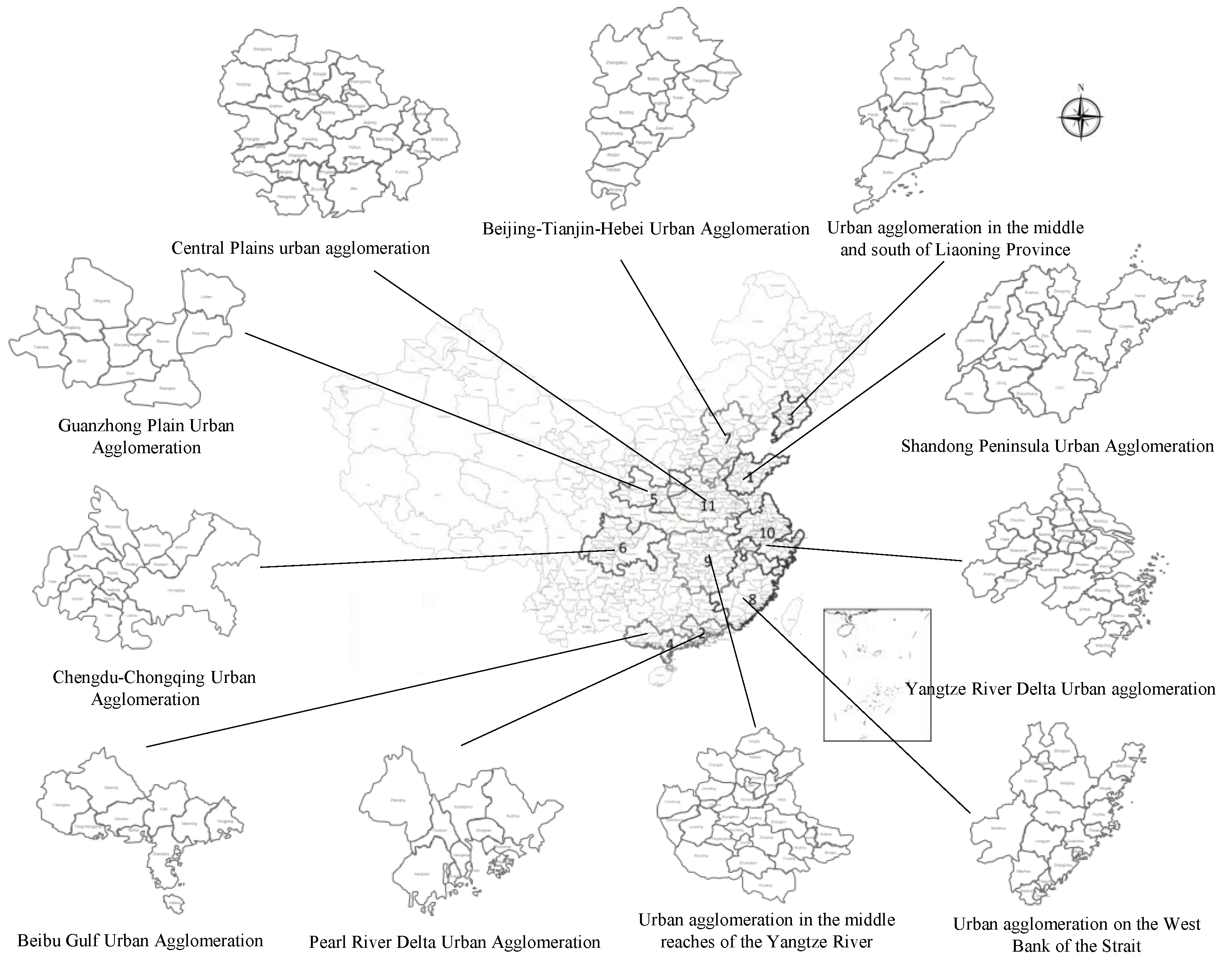
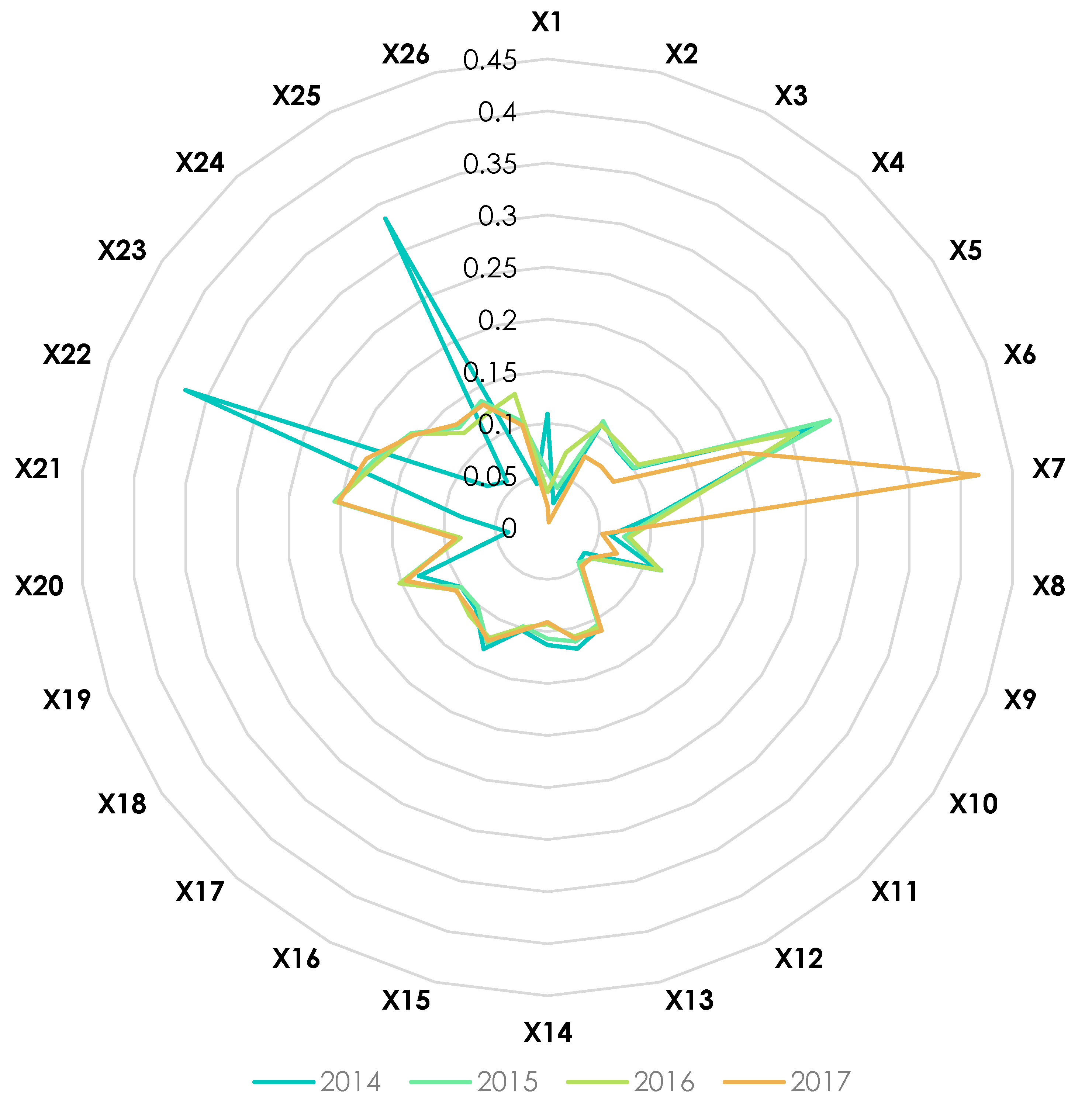
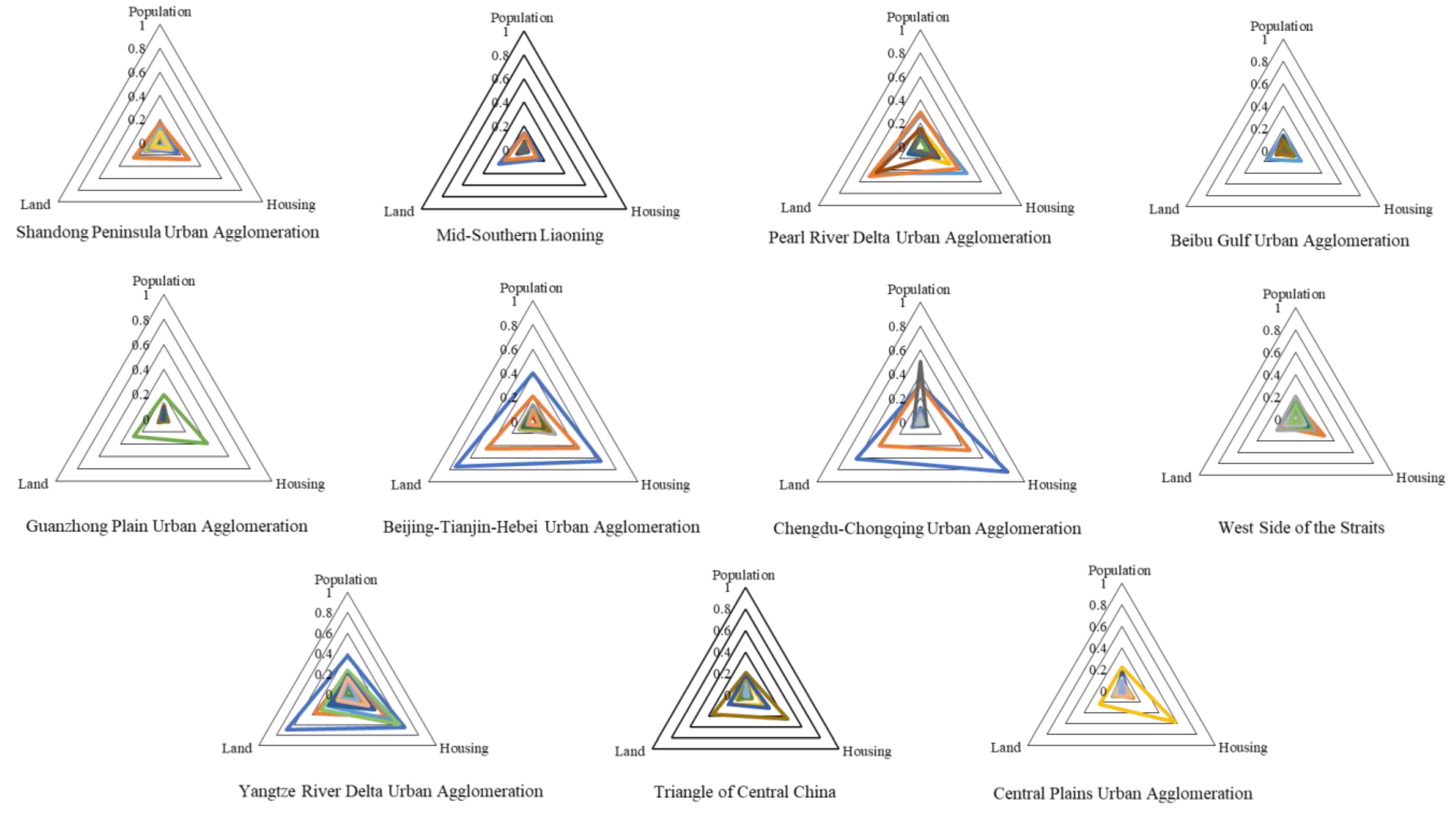


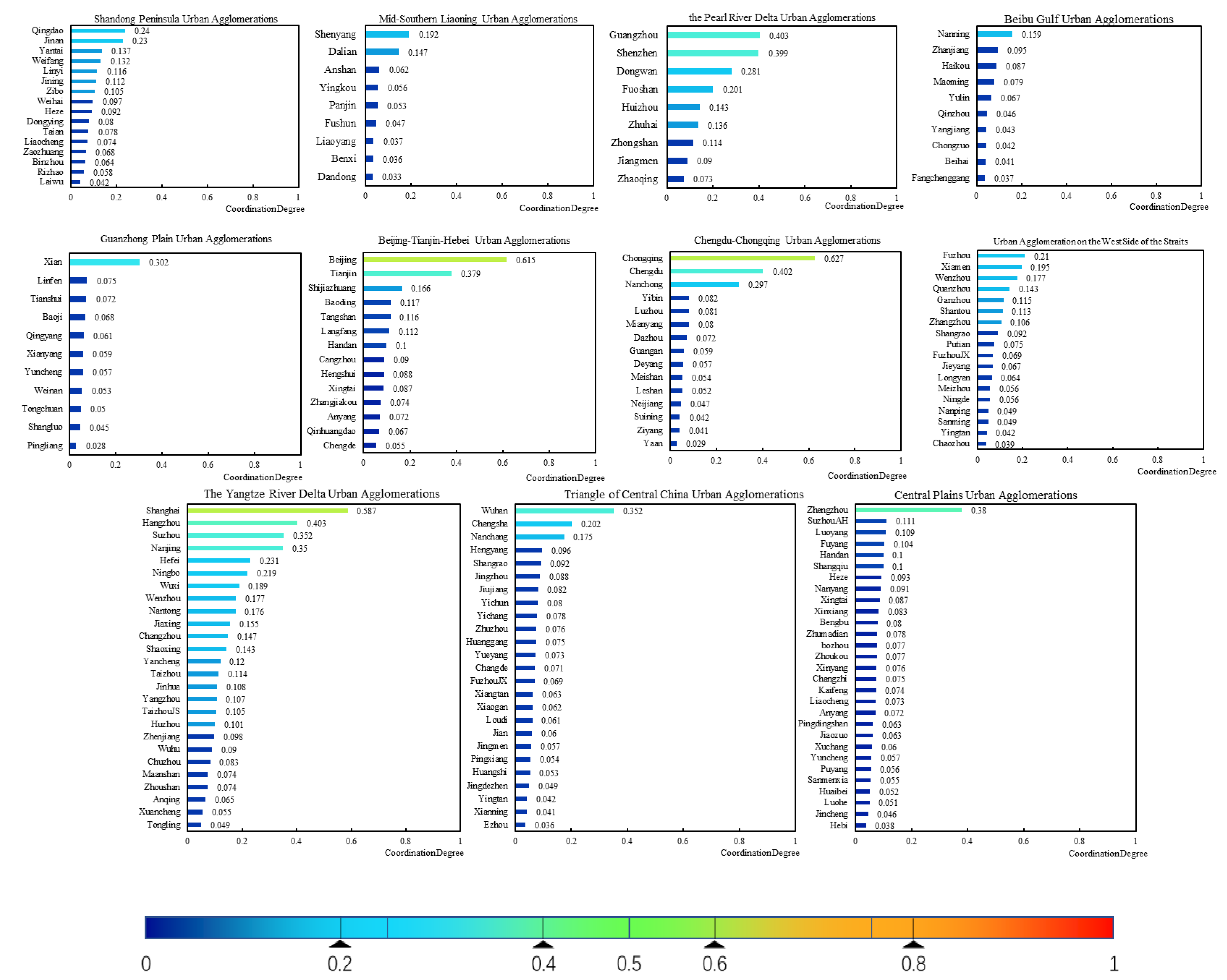

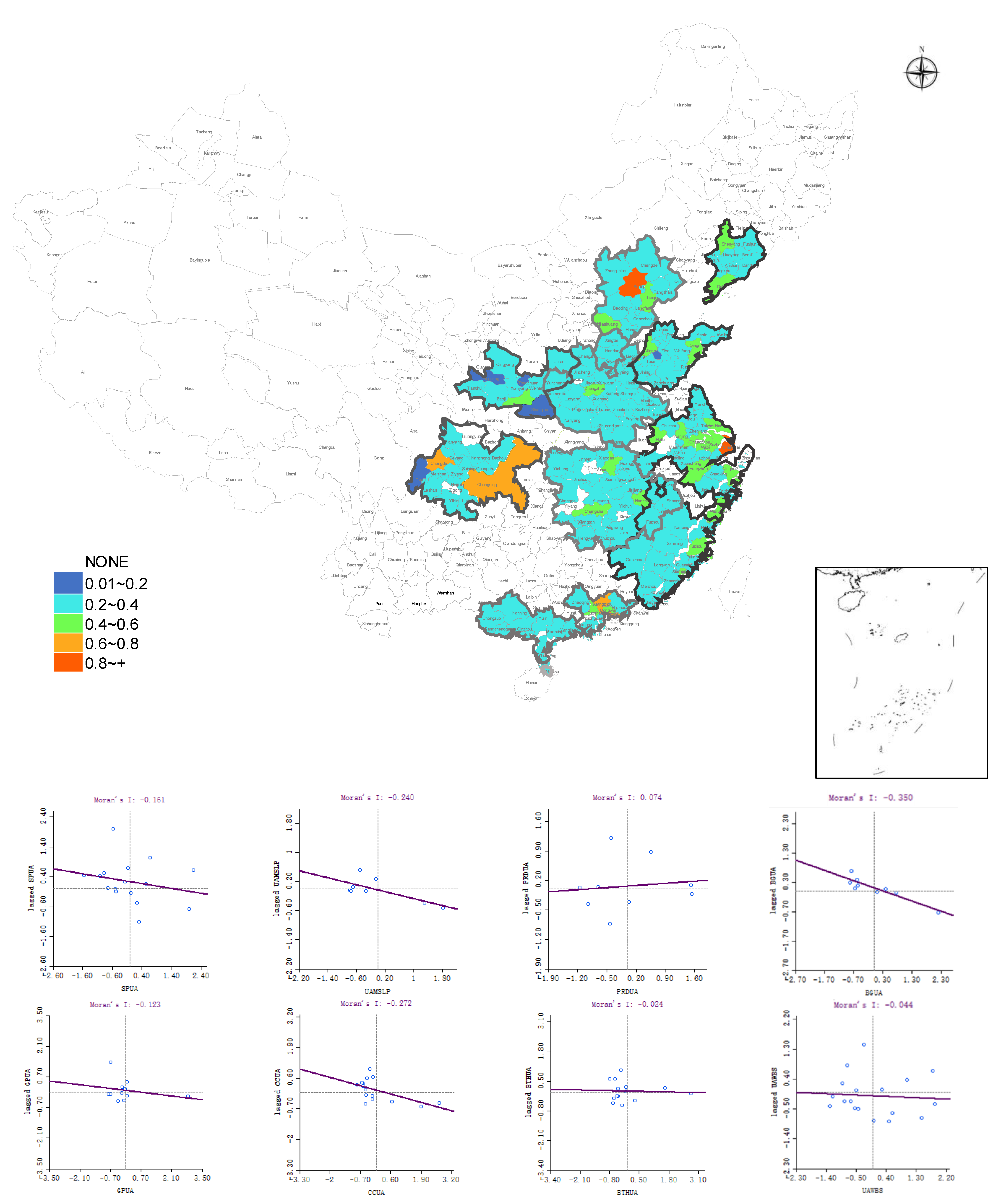

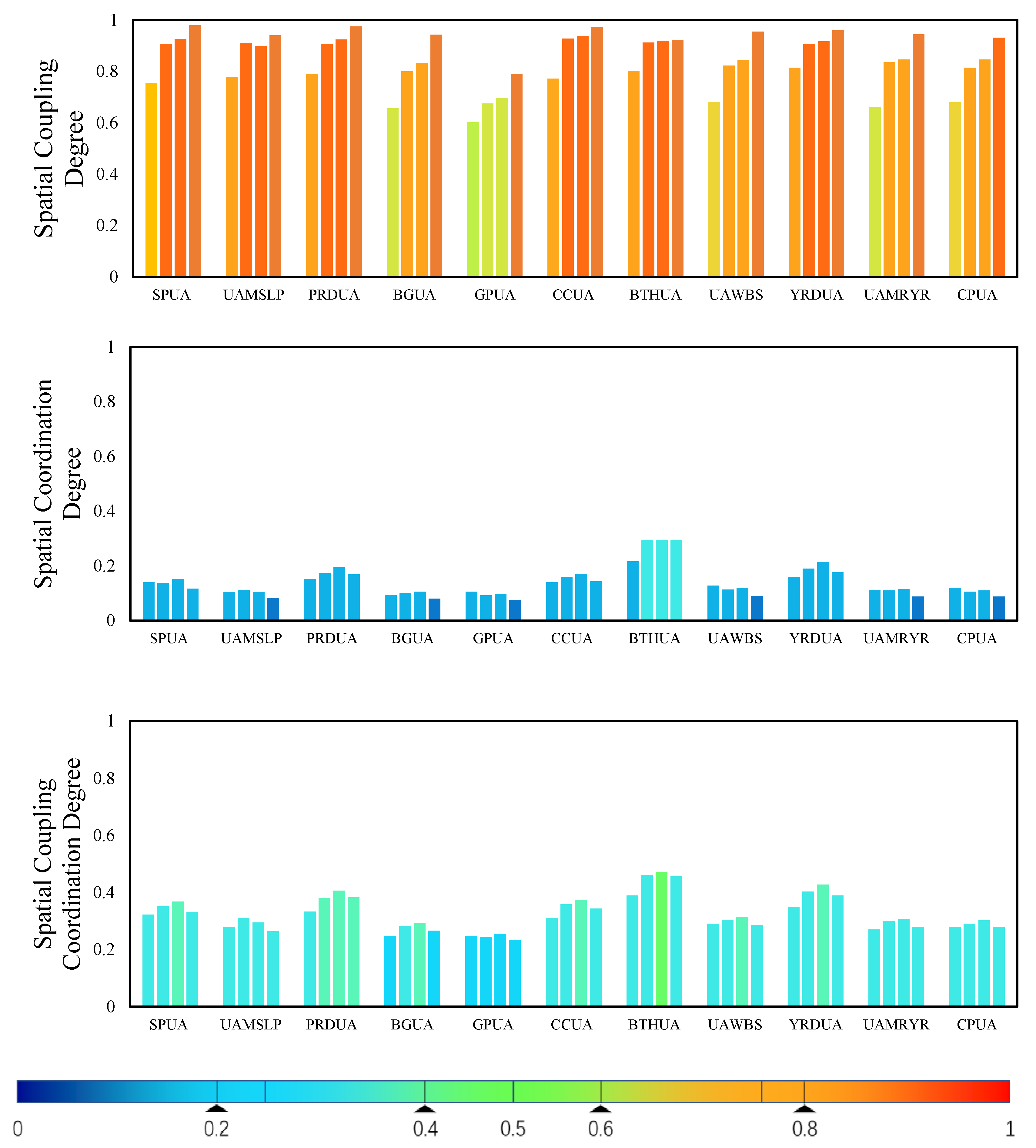
| Urban Agglomeration | Cities |
|---|---|
| Shandong Peninsula (SPUA) | Jinan, Qingdao, Yantai, Zibo, Weifang, Dongying, Weihai, Rizhao, Zaozhuang, Jining, Tai’an, Laiwu, Linyi, Liaocheng, Binzhou, Heze |
| Middle and south of Liaoning Province (UAMSLP) | Shenyang, Dalian, Anshan, Fushun, Benxi, Dandong, Liaoyang, Yingkou, Panjin |
| Pearl River Delta (PRDUA) | Guangdong, Shenzhen, Foshan, Dongguan, Zhongshan, Zhuhai, Jiangmen, Zhaoqing, Huizhou |
| Beibu Gulf (BGUA) | Nanning, Beihai, Fangchenggang, Qinzhou, Yulin, Chongzuo, Zhanjiang, Maoming, Yangjiang, Haikou |
| Guanzhong Plain (GPUA) | Xi’an, Baoji, Xianyang, Tongchuan, Weinan, Shangluo, Yuncheng, Linfen, Tianshui, Pingliang, Qingyang |
| Chengdu-Chongqing (CCUA) | Chongqing, Chengdu, Luzhou, Deyang, Suining, Neijiang, Leshan, Nanchong, Meishan, Yibin, Guang’an, Ziyang, Mianyang, Dazhou, Ya’an |
| Beijing-Tianjin-Hebei (BTHUA) | Beijing, Tianjin, Shijiazhuang, Tangshan, Qinhuangdao, Baoding, Zhangjiakou, Langfang, Chengde, Cangzhou, Hengshui, Xingtai, Handan, Anyang |
| West Bank of the Strait (UAWBS) | Fuzhou, Xiamen, Quanzhou, Putian, Zhangzhou, Sanming, Nanping, Longyan, Ningde, Wenzhou, Ganzhou, Yingtan, Fuzhou, Shangrao, Shantou, Meizhou, Chaozhou, Jieyang |
| Yangtze River Delta (YRDUA) | Shanghai, Nanjing, Wuxi, Changzhou, Suzhou, Nantong, Yancheng, Yangzhou, Zhenjiang, Taizhou, Hangzhou, Ningbo, Jiaxing, Huzhou, Shaoxing, Jinhua, Zhoushan, Taizhou, Hefei, Wuhu, Ma’anshan, Tongling, Anqing, Chuzhou and Xuancheng |
| Middle reaches of the Yangtze River (UAMRYR) | Wuhan, Huangshi, Yichang, Ezhou, Jingmen, Xiaogan, Jingzhou, Huanggang, Xianning, Changsha, Zhuzhou, Xiangtan, Yueyang, Hengyang, Changde, Loudi, Nanchang, Jingdezhen, Pingxiang, Jiujiang, Ji’an, Yichun, Yingtan, Fuzhou, Shangrao |
| Central Plains (CPUA) | Zhengzhou, Kaifeng, Luoyang, Anyang, Pingdingshan, Hebi, Xinxiang, Jiaozuo, Puyang, Xuchang, Luohe, Sanmenxia, Nanyang, Shangqiu, Xinyang, Zhoukou, Zhumadian, Bengbu, Huaibei, Fuyang, Suzhou, Bozhou, Liaocheng, Heze, Changzhi, Jincheng, Yuncheng, Xingtai, Handan |
| Indicator System | Indicator Type | Indicator | Unit | Code | Data Source |
|---|---|---|---|---|---|
| Population | pressure | Natural growth rate | (‰) | X1 | CCS |
| Population net inflow | ten thousand | X2 | CCS | ||
| state | Population density | Person/km2 | X3 | CUC | |
| Registered population at the year-end | ten thousand | X4 | CCS | ||
| Annual average population | ten thousand | X5 | CCS | ||
| Employee number at the year-end | ten thousand | X6 | CCS | ||
| response | Per capita GRP | Yuan | X7 | CCS | |
| Average salary of employees | Yuan | X8 | CCS | ||
| Per capita urban disposable income | Yuan | X9 | CCS | ||
| Land | pressure | New construction land area in land transfer | 10,000 square meters | X10 | CRE |
| Urban construction land area | square kilometer | X11 | CUC | ||
| state | Residential land | square kilometer | X12 | CUC | |
| Land for commercial service facilities | square kilometer | X13 | CUC | ||
| Industrial land | square kilometer | X14 | CUC | ||
| Land for public management and public service | square kilometer | X15 | CUC | ||
| Green coverage area of built-up area | hectare | X16 | CUC | ||
| response | Average land transfer price | Yuan/m2 | X17 | CRE | |
| Land transfer area | 10,000 square meters | X18 | CRE | ||
| Total land transfer fee | Ten thousand yuan | X19 | CRE | ||
| Housing | pressure | Completed investment in real estate development | RMB 100 mn | X20 | CRE |
| Completed investment in residential development | RMB 100 mn | X21 | CRE | ||
| state | Construction area of commercial housing | 10,000 square meters | X22 | CRE | |
| Completed area of commercial housing | 10,000 square meters | X23 | CRE | ||
| response | Average selling price of commercial housing | Yuan/m2 | X24 | CRE | |
| Sales of commercial housing | RMB 100 mn | X25 | CRE | ||
| Sales area of commercial housing | 10,000 square meters | X26 | CRE |
| Urban Agglomeration | Global Moran’s I | |||
|---|---|---|---|---|
| 2014 | 2015 | 2016 | 2017 | |
| Shandong Peninsula (SPUA) | −0.192 | −0.099 | −0.121 | −0.161 |
| Middle and south of Liaoning Province (UAMSLP) | −0.246 | −0.250 | −0.219 | −0.240 |
| Pearl River Delta (PRDUA) | −0.007 | 0.015 | −0.005 | 0.074 |
| Beibu Gulf (BGUA) | −0.384 | −0.362 | −0.275 | −0.350 |
| Guanzhong Plain (GPUA) | −0.043 | −0.138 | −0.097 | −0.123 |
| Chengdu–Chongqing (CCUA) | −0.241 | −0.224 | −0.232 | −0.272 |
| Beijing–Tianjin–Hebei (BTHUA) | −0.042 | −0.045 | −0.015 | −0.024 |
| West Bank of the Strait (UAWBS) | 0.143 | 0.069 | 0.111 | −0.044 |
| Yangtze River Delta (YRDUA) | 0.076 | 0.066 | −0.024 | 0.084 |
| The middle reaches of the Yangtze River (UAMRYR) | −0.225 | −0.197 | −0.210 | −0.225 |
| Central Plains (CPUA) | 0.104 | 0.001 | −0.017 | −0.024 |
Publisher’s Note: MDPI stays neutral with regard to jurisdictional claims in published maps and institutional affiliations. |
© 2022 by the authors. Licensee MDPI, Basel, Switzerland. This article is an open access article distributed under the terms and conditions of the Creative Commons Attribution (CC BY) license (https://creativecommons.org/licenses/by/4.0/).
Share and Cite
Kong, Q.; Kong, H.; Miao, S.; Zhang, Q.; Shi, J. Spatial Coupling Coordination Evaluation between Population Growth, Land Use and Housing Supply of Urban Agglomeration in China. Land 2022, 11, 1396. https://doi.org/10.3390/land11091396
Kong Q, Kong H, Miao S, Zhang Q, Shi J. Spatial Coupling Coordination Evaluation between Population Growth, Land Use and Housing Supply of Urban Agglomeration in China. Land. 2022; 11(9):1396. https://doi.org/10.3390/land11091396
Chicago/Turabian StyleKong, Qingshan, Haiyang Kong, Silin Miao, Qin Zhang, and Jiangang Shi. 2022. "Spatial Coupling Coordination Evaluation between Population Growth, Land Use and Housing Supply of Urban Agglomeration in China" Land 11, no. 9: 1396. https://doi.org/10.3390/land11091396
APA StyleKong, Q., Kong, H., Miao, S., Zhang, Q., & Shi, J. (2022). Spatial Coupling Coordination Evaluation between Population Growth, Land Use and Housing Supply of Urban Agglomeration in China. Land, 11(9), 1396. https://doi.org/10.3390/land11091396






